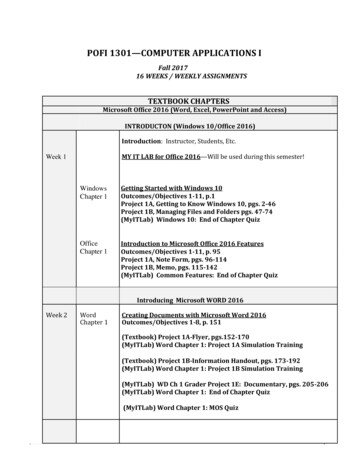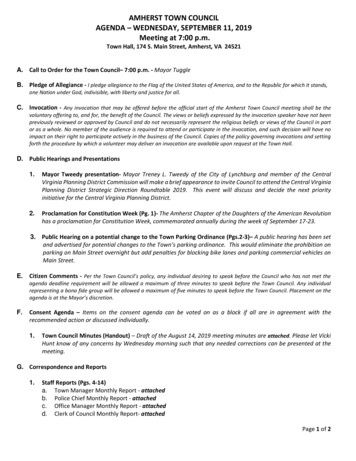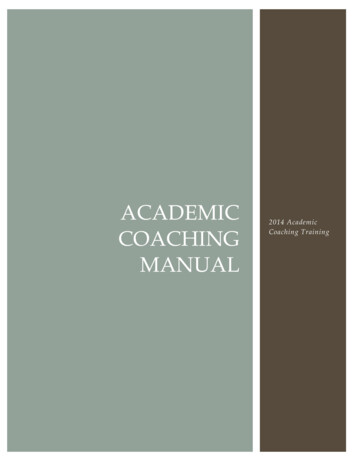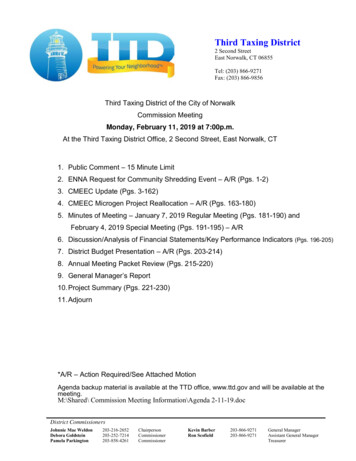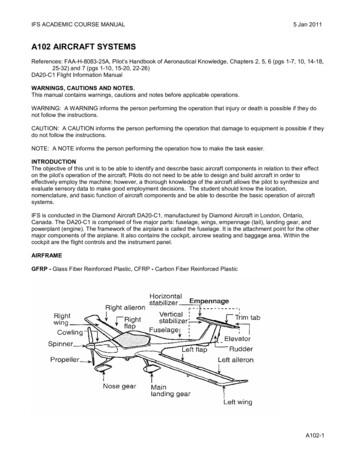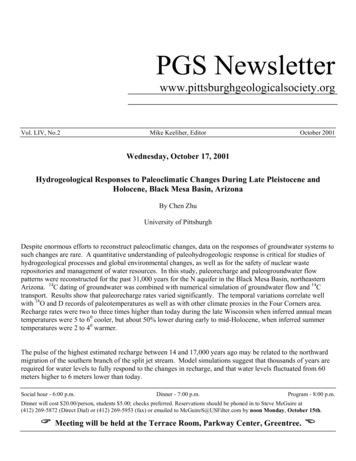
Transcription
PGS Newsletterwww.pittsburghgeologicalsociety.orgVol. LIV, No.2Mike Keeliher, EditorOctober 2001Wednesday, October 17, 2001Hydrogeological Responses to Paleoclimatic Changes During Late Pleistocene andHolocene, Black Mesa Basin, ArizonaBy Chen ZhuUniversity of PittsburghDespite enormous efforts to reconstruct paleoclimatic changes, data on the responses of groundwater systems tosuch changes are rare. A quantitative understanding of paleohydrogeologic response is critical for studies ofhydrogeological processes and global environmental changes, as well as for the safety of nuclear wasterepositories and management of water resources. In this study, paleorecharge and paleogroundwater flowpatterns were reconstructed for the past 31,000 years for the N aquifer in the Black Mesa Basin, northeasternArizona. 14C dating of groundwater was combined with numerical simulation of groundwater flow and 14Ctransport. Results show that paleorecharge rates varied significantly. The temporal variations correlate wellwith 18O and D records of paleotemperatures as well as with other climate proxies in the Four Corners area.Recharge rates were two to three times higher than today during the late Wisconsin when inferred annual meantemperatures were 5 to 60 cooler, but about 50% lower during early to mid-Holocene, when inferred summertemperatures were 2 to 40 warmer.The pulse of the highest estimated recharge between 14 and 17,000 years ago may be related to the northwardmigration of the southern branch of the split jet stream. Model simulations suggest that thousands of years arerequired for water levels to fully respond to the changes in recharge, and that water levels fluctuated from 60meters higher to 6 meters lower than today.Social hour - 6:00 p.m.Dinner - 7:00 p.m.Program - 8:00 p.m.Dinner will cost 20.00/person, students 5.00; checks preferred. Reservations should be phoned in to Steve McGuire at(412) 269-5872 (Direct Dial) or (412) 269-5953 (fax) or emailed to McGuireS@USFilter.com by noon Monday, October 15th. Meeting will be held at the Terrace Room, Parkway Center, Greentree.
Pittsburgh Geological SocietyIn the wake of the September 11thtragedy, the 2001 Pittsburgh GeologicalSociety along with Geology OfPennsylvania Committee is donating 1000 to the Salvation Army in NewYork City. The board approved the giftduring our September meeting and avolunteer committee selected the charity.Licensing of Geologists in the State of New YorkThe Buffalo Association of Professional Geologistsreports that a NY State Senate version of a bill tolicense geologists in New York has passed and aversion in the NY State Senate also must pass inorder to become law.Note: The editor would welcome news of anylicensing activity in surrounding states for thebenefit of our members.PGS has a New Constitution and By-LawsChuck Shultz and his committee has reworked andupdated the old constitution and by-laws. Memberswho are interested in obtaining a copy shouldcontact one of the board members at the nextmeeting.IMPROVEMENTS IN THE STATEBOOKSTOREFor those of you who have been frustrated over theyears trying to obtain publications from the StateBookstore in Harrisburg, here is some great news.The State Bookstore, formerly operated by theDepartment of General Services and located onStanley Drive, was taken over recently by theHistorical and Museum Commission and is nowlocated in the atrium of the new PennDOT building(Keystone Building). Visa and MasterCardpayments are now accepted, and credit card orderscan be made by telephone. They will also invoice.The public can still walk in and buy books, and thetelephone number remains the same at 717-787-5109. The hours are 10 a.m. to 4 p.m., Mondaythrough Friday. The new address is: StateBookstore, Commonwealth Keystone Building,Plaza Level, 400 North Street, Harrisburg, PA17120-0053. An online catalog will be available onthe PHMC web site in the near future.NEW PENNSYLVANIA GEOLOGICALSURVEY PUBLICATIONSThe Pennsylvania Geological Survey has recentlyissued two new Educational Series booklets thatwill be of use to earth science teachers and anyoneelse with an interest in well-written generalinformation on geology. The first is ES 9,“Landslides in Pennsylvania,” revised by PGSmember Helen Delano from “Geologic Hazards ofPennsylvania” (the previous title of ES 9). Theolder booklet, published in 1979 by the late J. PeterWilshusen, contained information on landslides,earthquakes, and sinkholes. When the Surveyissued separate publications on earthquakes (ES 10)and sinkholes (ES 11), it was decided that ES 9should be revised to include only landslides. Thesecond booklet is ES 12, “The Non-fuel MineralResources of Pennsylvania,” by John H. Barnes andRobert C. Smith, II. It is a compendium ofinformation on aggregate and constructionresources such as gravel and limestone to metallicresources such as iron and copper to miscellaneousresources such as salt. Both of these publicationsare free of charge. To obtain a copy, call JohnHarper at 412-442-4230 or email atjharper@state.pa.us. For multiple copies, contactthe Pennsylvania Geological Survey in Harrisburgat 717-787-2169.FIELD CONFERENCE GUIDEBOOKS FORSALEIf you are interested in some of the guidebooks forpast Field Conferences of Pennsylvania Geologists,a limited number is available by contacting JohnHarper at 412-442-4230, email:jharper@state.pa.us. In most abundance is theguidebook for the 2000 Field Conference held herein Pittsburgh last year.
LOOKING FOR WORK?The New Jersey Department of EnvironmentalProtection is hiring (entry-level only, regardless ofexperience). Anyone interested should contactMary Anne Kuserk, Chief, Bureau of Ground WaterPollution Abatement, Department of EnvironmentalProtection, 401 E. State Street, 4th Floor, P.O. Box413, Trenton, NJ 08625. Her telephone number is(609) 84-4421. You can fax resumes to (609) 2920848 ATTN Mary Anne Kuserk, or e-mail to:mkuser@dep.state.nj.us. You do NOT need to be aNew Jersey resident to be interviewed, hired, oremployed.DID YOU KNOW . . .? Geologists working in China have foundevidence for a sulfur and strontium isotopeexcursion in end-Permian rocks that they thinkindicates the great Permian extinction resultedfrom a bolide impact. A curved shape is one of the commoncharacteristics of convergent plate boundariesworldwide. Because hydrogen has the largest relative massdifference between its stable isotopes, it has thelargest natural variations in stable isotope ratios. A team of geologist from Nebraska has foundevidence that the climate of western Pangeaduring the Jurassic Period was characterized bystrong, dry, winter winds and summermonsoons. Hawaii went through a debate on evolution inJuly – a proposed Board of Education change inlanguage from “biological evolution” to“multiple theories of origin” was defeated afterscientists became involved and overwhelmed apublic meeting in early August. Tropical storm Allison cased an estimated 5billion dollars in damage during its sweepthrough the Gulf of Mexico this summer, and itwasn’t even strong enough to be called ahurricane! USGS geologists examining volcanic slopestability on Mt. Rainier found that flankcollapse greater than 0.1 cubic kilometers occurs as a result of large amounts of weak,hydrothermally altered rock situated high onsteep slopes.By the early 1800s Philadelphia was wellknown as the primary center of natural scienceon the American side of the Atlantic Ocean,housing such prestigious institutions as theAmerican Philosophical Society and theAcademy of Natural Sciences.The Laurentian continental margin was a slowlysubsiding subtropical carbonate shelf from theCambrian to the Early Ordovician.The invasion of land by arthropods, probably inthe Silurian or Early Devonian, is considered tobe one of the most significant events in thehistory of life on earth.Website of the earthlights dmsp big.jpg.Election WoesFor those of you who attended last month’smeeting, you were asked to vote on a slate of boardmembers. As it turns out, there was a mistake onthe ballot and members will be asked to vote again.Thank you for your patience.Expanded Newsletter. Maybe?Generally the newsletter is restricted to four pagesdue to printing costs and my children: “I can’t foldanymore, daddy, my fingers are bleeding.”However I can easily add some sections to the emailed version. Some possibilities might be: helpwanted ads, change of address, change of company,book reviews, outcrop locations etc. Don’t be shyabout submitting stuff; it’s your chance to get yourname in print, at least electronically.If you have any information you would like to haveincluded in the PGS Newsletter, please submit it toMike Keeliher at 4590 Dutch Ridge Road, Beaver,PA 15009 or e-mail: keeliher@bellatlantic.net
President:Vice President:Treasurer:Secretary:Fred CollJudy NeelanSteve McGuireFrank BenaquistaPast President: Wendell BarnerBoard member:Board member:Board member:Board member:GOPCOMembershipHistorian.Chuck ShultzPete BriggsJohn HarperPaul GarrettMemberships: For information about memberships, please write PGS Membership Chair, PO Box 58172, Pittsburgh PA 15209,or call John Harper at (412) 442-4230, or e-mail jharper@state.pa.us. Membership information can also be found at our newwebsite.PGS phone line: (412) 928-2255PGS web RGH GEOLOGICAL SOCIETYPO Box 58172Pittsburgh PA 15209PGS 2001 Corporate SponsorsAbarta Oil & Gas Co., Inc.American Geotechnical and EnvironmentalServices, Inc.John A. Ames, Inc.ARK Resources, Inc.Aurora Environmental, Inc.The Baron GroupBenedum InterestsCummings Riter Consultants, Inc.Earth, Inc.Eberly & Meade, Inc.Environmental Assessment Co.The Fourth River CompanyGAI Consultants, Inc.Gannett FlemingGeoData CorporationGeo-Environmental Drilling Co.GeoMechanics, Inc.Geotechnics, Inc.HDR Engineering, Inc.L.G. Hetager Drilling, Inc.The Hutchinson Group, Ltd.HydroSystems Management, Inc.The IT GroupSamuel T. Pees & AssociatesRadian InternationalPaul C. Rizzo AssociatesSE Technologies, Inc.Shield Environmental Associates, Inc.Test Boring Services, Inc.Vista Resources, Inc.
PGS Newsletterwww.pittsburghgeologicalsociety.orgVol. LIV, No.3Mike Keeliher, EditorNovember 2001Wednesday, November 14, 2001The Portage EscarpmentMichael Wilson, PhD, SUNY FredoniaFrom the vantage point of a modern space platform, the most prominent features of northeastern Ohio,northwestern Pennsylvania and southwestern New York consist of the familiar Lake Erie basin and the adjacentAllegheny Plateau. The view reminds us that the north edge of the plateau is a1000-foot high escarpment,which drains to the St. Lawrence River and North Atlantic Ocean, while the top of the plateau tilts gentlysouthward and ultimately drains to the Gulf of Mexico. Glacial end moraines at the top edge of the plateaucommonly form the ultimate divide between the Mississippi and St. Lawrence basins, especially the LakeEscarpment Moraine dated at about 14,000 years before present. Although the escarpment likely functioned toinhibit canoe travel by native peoples, it was a critical issue for travel for early explorers and colonialexpansionists. French and British interests collided in the mid-1700s as then 21- year old George Washingtonwas sent by the colonial Governor of Virginia to northwestern Pennsylvania to discover French intentionsconcerning the frontier. In the few preceding years the French had sent expeditionary forces into theChautauqua Creek and French Creek watersheds to define a canoe portage route to link their St. Lawrenceterritories with their Mississippi territories. Ever since the escarpment has been known as the PortageEscarpment and has typically been a cause of cultural division. Resources south of the escarpment were linkedto Pittsburgh while resources to the north were linked to Great Lakes ports or central New York. Theescarpment has divided, and continues to divide, the region in many ways: oil to the south and gas to the north,water wells to the south and reservoirs to the north, small lake recreation to the south and Great Lakes to thenorth, dairying to the south and vineyards to the north, and so on. The details of the escarpment also offerseveral subjects of interest; one for example, selective plugging or breaching of very small parts of the glacialend moraine will divert politically significant water across a "continental" drainage divide. And finally, one lastsubject for the evening: Why is the escarpment there?Dr. Wilson is a professor at SUNY Fredonia with a Doctorate from Syracuse University in geology andgeotechnical engineeringSocial hour - 6:00 p.m.Dinner - 7:00 p.m.Program - 8:00 p.m.Dinner will cost 20.00/person, students 5.00; checks preferred. Reservations should be phoned in to Steve McGuire at(412) 269-5872 (Direct Dial) or (412) 269-5953 (fax) or emailed to McGuire@USFilter.com by noon Monday, November 12. Meeting will be held at the Terrace Room, Parkway Center, Greentree.
Pittsburgh Geological SocietyGrandmas and GrandpasFrom the October newsletter of the Buffalo Association ofProfessional GeologistsThe grandfathering period for professional geologists’licenses in New Hampshire is now open until June 30,2002. Those interested in a license to practice as aprofessional geologist in that state may obtain anapplication by submitting your name and address by email to dlobdell@nhsa.state.nh.us, or fax (603) 2716990 or phone (603) 271-2219 or download atwww.state.nh.us/jtboard/geo.htm.Student Positions at PADOTSubmitted by William Adams, Jr. PhD, PADOTThe geotechnical unit of the Pennsylvania Department ofTransportation, Engineering District 11-0 will besoliciting candidates for several positions in theGeotechnical Unit. These are for students majoring ingeology, earth science, engineering geology, civilengineering and geotechnical engineering.Opportunities include positions in the CooperativeProgram, internships in the Rockfall Hazard Ratingsproject, and Geographic Information Systems. Pay is 9.96 per hour.There will be several forms available at the meeting forinterested students or you may call William Adams Jr. at412-429-4919 or e-mail at bsgadams@telerama.comPTTC Announcement for PGS MembersDON’T FORGET TO RENEW YOURMEMBERSHIPIf you have a number next to your name on the mailinglabel, we have not yet received your dues renewal.Please fill out a membership form and mail your checkmade payable to “Pittsburgh Geological Society” (or just“PGS”) for the proper amount - 20 for regular membersand 5 for students – and mail it to John Harper,Pennsylvania Geological Survey, 400 Waterfront Drive,Pittsburgh, PA 15222-4745. Anyone who is in arrearson dues as of the January meeting will be dropped fromthe membership roles and will no longer receive thenewsletter. If you don’t have a membership form fromthe September newsletter, you can obtain one by logginginto the new PGS / andclicking on “Membership”.NEW HONORARY MEMBERS NAMEDThe PGS Board of Directors is pleased to announce theaddition of two new names to our list of honorarymembers. Thomas W. Angerman and Mary S. Robisonare both long-time members of PGS who have beeninstrumental in the betterment of the society and thegeologic community. Congratulations Tom and Mary.GSA ISSUES POSITION STATEMENTSON EDUCATION AND EVOLUTIONFrom: Katharine Lee Avary, avary@geosrv.wvnet.eduNovember 8th, PTTC will bring together sixindependent operators who are conducting field-orientedresearch projects funded by DOE. Case studies of all sixprojects will be presented, two of which are Appalachianbasin projects funded through the Stripper Gas WellProgram. Summaries of the following will be presented:Low Cost Methodologies to Analyze and CorrectAbnormal Production Declines in Stripper Gas Wells(James Engineering), Advanced Technologies forStripper Gas Well Improvement (Holditch ReservoirTechnologies), On-Lease Power Generation (AmericanWarrior), Water flooding (Coral Production company),Developing Marginal Expenses Oil Well WirelessSurveillance System (Hunter Living Trust; HunterEdison Oil Development), and Solving DecliningProduction Problems (MNA Enterprises LTD). Theworkshop will be held at the Holiday Inn in Washington,PA. Look for "Field-Oriented Research Projects forIndependents" on our website.The Geological Society of America has issued twoposition statements that might be of interest to PGSmembers. One deals with Scholarship and ProfessionalActivity in Geoscience Public Policy and GeoscienceEducation, and the other deals with Evolution. Membersinterested in reading these statements can find themonline hose without internet access who would like to readthese can get copies by calling John Harper at (412) 4424230.As if adjusting to Eastern Standard Time weren’t enough,remember that this month’s meeting is being bumped up aweek to keep us clear of the Thanksgiving Holiday—pleasehave a peaceful one.
DID YOU KNOW . . . ?Submitted by John Harper The first recorded natural history paper describinggeology in Pennsylvania was A Cascade Near theOhiopile [sic] Falls of the Youghiogeny [sic], TwelveMiles From Uniontown, Fayette County,Pennsylvania by Thomas Hutchins, published in theTransactions of the American Philosophical Society(v. II, p. 50) in 1786.Although the fossil record shows that fungi andplants first colonized the land about 460 to 480million years ago, studies of molecular clocks (usingknowledge of gene mutations) suggest it actuallyoccurred about 600 million years ago.A new computer model used by astrophysicistssuggests that the Moon formed near the end ofEarth’s formation when our planet was hit by aplanetoid the size of Mars.The world’s oldest known (to date) fossil charcoalwas described from the Upper Devonian CatskillFormation of Clinton County, Pennsylvania. It hasbeen interpreted as evidence of an early wildfireassociated with Late Devonian seasonal wet and dryclimates.The Allegheny County Courthouse, built in 1884, ismade of gray granite from Milford, New Hampshire.Scientists at the USGS and the Centers for DiseaseControl and Prevention (CDC) are studying thefeasibility of using remote sensing and GIS to locateboth the extents of disaster areas and those areas thathost disease-causing pathogens, such as swamps thatharbor mosquitoes.Hydrothermal (also called “saddle”) dolomite, thevariety of the mineral that occurs as a result of hotbrines migrating through and dolomitizinglimestone, forms in curved or twisted rhombiccrystals.Although none of the local Pittsburgh arealimestones are currently considered of economicquality or quantity, in earlier years many werequarried on a small scale to obtain stone foragricultural lime.The current “hot” gas play in the Appalachian basin,the Trenton-Black River play, is the search for highpressure gas deposits in vuggy dolomite foundassociated with deep faults and fractures.Website of the month:http://www.volcano.si.edu/gvp/usgsWhen a volcano lets fly or an earthquake bringsdown a mountainside, people look upon the eventand report it to each other as news. People, intheir whole history, have seen comparatively fewsuch events; and only in the past couple of hundredof years have they begun to sense the patterns theevents represent. Human time, regarded in theperspective of geologic time, is much too thin to bediscerned—the mark invisible at the end of a ruler.If geologic time could somehow be seen in theperspective of human time on the other hand, sealevel would be rising and falling hundreds of feet,ice would come pouring over continents and asquickly go away. Yucatans and Floridas would beunder the sun the next minute and underwater thenext, oceans would swing open like doors,mountains would grow like clouds and come downlike melting sherbet, continents would crawl likeamoebae, rivers would arrive and disappear likerainstreaks down an umbrella, lakes would goaway like puddles after rain, and volcanoes wouldlight the earth as if were a garden full of fireflies.At the end of the program, man shows up—histicket in his hand. Almost at once he conceives ofprivate property, dimension stone and lifeinsurance. When a Mt. St. Helens assaults hissensibilities with an ash cloud eleven miles high, hewrites a letter to the New York Timesrecommending that the mountain be bombed.John McPhee, In Suspect TerrainIf you have any information you would like to haveincluded in the PGS Newsletter, please submit it toMike Keeliher at 4590 Dutch Ridge Road, Beaver,PA 15009 or e-mail: keeliher@bellatlantic.net
The PGS Board:President: Fred CollVice President: Judy NeelanTreasurer: Steve McGuireSecretary: Frank BenaquistaDirectors-at-Large:Bruce Camlin, Patrick Burkhart,Chris Ruppen, Ed GirardChuck Shultz, Bob BurgerCounselor and GOPCO Chairman:Pete BriggsCounselor: John HarperPast President: Wendell BarnerMemberships: For information about memberships, please write PGS Membership Chair, PO Box 58172, Pittsburgh PA 15209,or call John Harper at (412) 442-4230, or e-mail jharper@dcnr.state.pa.us. Membership information can also be found at our newwebsite.PGS phone line: (412) 928-2255PGS web address: www.pittsburghgeologicalsociety.orgPITTSBURGH GEOLOGICAL SOCIETYPO Box 58172Pittsburgh PA 152092000 CORPORATESPONSORSAbarta Oil & Gas Co., Inc.American Geotechnical and EnvironmentalServices, Inc.John A. Ames, Inc.ARK Resources, Inc.Aurora Environmental, Inc.The Baron GroupBenedum InterestsCummings Riter Consultants, Inc.Earth, Inc.Eberly & Meade, Inc.Environmental Assessment Co.The Fourth River CompanyGAI Consultants, Inc.Gannett FlemingGeoData CorporationGeo-Environmental Drilling Co.GeoMechanics, Inc.Geotechnics, Inc.HDR Engineering, Inc.L.G. Hetager Drilling, Inc.The Hutchinson Group, Ltd.HydroSystems Management, Inc.The IT GroupSamuel T. Pees & AssociatesRadian InternationalPaul C. Rizzo AssociatesSE Technologies, Inc.Shield Environmental Associates, Inc.Test Boring Services, Inc.Vista Resources, Inc.
PGS Newsletterwww.pittsburghgeologicalsociety.orgVol. LIV, No.4Mike Keeliher, EditorDecember 2001Wednesday, December 19, 2001Spouses Night and LectureGeology as seen on the Fall 2000 voyage of the SS Universe Explorer -or how turmoil in the World keptus out of the Mediterranean Sea again. In addition, a short trip to landlocked Bolivia.By Michael Bikerman, PhD, PGAcademic Dean of University of Pittsburgh’s Semester at Sea 2000Our Semester at Sea Fall 2000 Voyage of Discovery started auspiciously from a geological perspective - visiting Olympic NationalPark for a couple of days prior to boarding the ship in Vancouver. Once the 627 students, 45 adult passengers, 26 faculty, 37 staff,along with 31 spouses and children boarded the 23,000 ton SS Universe Explorer on 23 September 2000 and passed below the LionsGate Bridge on our way to open water, the excitement became palpable. People waving from all the decks to friends and strangers inStanley Park watching us sail by from vantage points in volcanic tuff.Five days out our first true geologic experience, seeing an eruption of steam from Mt. Korovin on Atka Island in the Aleutians,unfortunately a bit too far away for a good picture. Vulcan again showed his hand the day before reaching Kobe, with an eruption ofMt. Miyaki - again a steam explosion. Kobe has recovered from the 1995 earthquake well, but has made major changes in an attemptto prevent such catastrophic damage when the next one hits.After Japan, China, docking in Shanghai. Later a flight to Guilin and a trip down the Li River to see the karst topography madefamous by Chinese artists for over a millennium. Then: Vietnam, with a flight to Cambodia to see the Temples of Angkor - truly oneof the Wonders of the World! A trip which also allowed us to see major flooding of the Mekong River from the air and on theground.Malaysia was a good place to study beach and tropical rainforest features.India was the site of a nice field trip, arranged by a formerstudent from Pitt with the help of the Geological Survey of India, to see the type locality of charnockite - peculiar dark coloredhypersthene granite, and other local outcrops. At this point of the voyage we were diverted from our intended course through theSuez Canal to the southern route via Africa and South America.In Kenya we did a safari, which allowed us to see many animals, and some quite recent lava flows. In South Africa, lunch with Nobelpeace prize laureate Archbishop Tutu, a chance to visit Table Mountain and coastal geology to Cape Point below the Cape of GoodHope.Brazil was the scene of my first ever field trip on a sailboat, and in our last stop, Cuba, we met Fidel Castro.Some months later a chance to visit Bolivia and see some of the best dinosaur footprints in the world. A selection of slides from theseexperiences will allow a vicarious voyage!Mike is an emeritus professor of Planetary Science at the University of Pittsburgh and a research associate at the Carnegie Museumof Natural history. He has taught undergraduate courses in Physical Geology, Historical Geology and a variety of upper divisionsubjects including Ore Deposits, Geochemistry, Earth Physics and graduate level Isotope Geochemistry and graduate seminars. Hehas been an active and welcomed member of PGS for many years.Social hour - 6:00 p.m.Dinner - 7:00 p.m.Program - 8:00 p.m.Dinner will cost 20.00/person, students 5.00; checks preferred. Reservations should be phoned in to Steve McGuire at(412) 269-5872 (Direct Dial) or (412) 269-5953 (fax) or emailed to McGuireS@USFilter.com by noon Monday, December 17th. Meeting will be held at the Terrace Room, Parkway Center, Greentree.
Pittsburgh Geological SocietyHank Williams to speak in January 2002Dr. Pat Burkhart of Slippery Rock University hasarranged to have Harold (Hank) Williams present a talkto the Society in January 2002. Hank Williams is amapper and compiler of the Appalachian-Caledonianorogen and one of the first global experts on ophioliteemplacement. On continental margins, he is probablyNewfoundland’s most accomplished and best-knownscientists. (OK, its not who you thought it was going tobe.) A much-honored researcher, rigorous but reveredteacher and colorful, dynamic and inspirational lecturer,he is also a celebrity in both learned and less-learnedcircles as a fiddle virtuoso and as a savant of wit with adistinctively Newfoundland flavor.He has over 250 papers to his credit and for severalyears has been Canada’s most cited geoscientist. Theabstract for his talk titled,” Patterned Orogeny in EasternCanada” will appear in January’s newsletter.Members AbroadSubmitted by Jim HamelIn late October, Jim and Betsy Hamel of HamelGeotechnical Consultants took a 12-day architecturaltour through central Honshu, the largest island of Japan.They studies wooden farmhouses, tea houses andtemples in rural areas. They also visited the new MihoMuseum, designed by I.M. Pei and constructed in a cutand cover in a mountainside near Kyoto. In the JapanAlps, they observed highway construction, includingvarious slope stabilization measures and visited severalconcrete gravity and arch dams as well as the highest(120 meters) rockfill dam in Japan.Watershed Atlas of Western Pennsylvaniafrom Alleghenies Watershed NETWORK NOTESOn November 15, 2001 the Pennsylvania EnvironmentalCouncil and Alleghenies Watershed Network willpremier the redesigned Watershed Atlas of theAllegheny River.The new Watershed Atlas of Western Pennsylvania willinclude the Monongahela River watershed, whichencompasses the Youghiogheny, Cheat, West Fork andTygart River watersheds. Users will be able to explorethe rich heritage of the Mon Valley, experience thenatural and historic resources of the rivers, and learnmore about the impact these rivers have on southwesternPennsylvania and northern West Virginia. Like theWatershed Atlas of the Allegheny River, the expandedAtlas will also use photographs, maps, diagrams, andtext to teach important and fascinating lessons about ourwatersheds.Log on to www.watershedatlas.org.HAVE YOU RENEWED YOURMEMBERSHIP?If you have a highlighted number next to your nameon the mailing label, we have not yet received yourdues renewal. Please fill out a membership formand mail your check made payable to “PittsburghGeological Society” (or just “PGS”) for the properamount - 20 for regular members and 5 forstudents – and mail it to John Harper, PennsylvaniaGeological Survey, 400 Waterfront Drive,Pittsburgh, PA 15222-4745. Anyone who is inarrears on dues as of the January meeting will bedropped from the membership roles and will nolonger receive the newsletter. If you don’t have amembership form from the September newsletter,you can obtain one by logging into the new org/ andclicking on “Membership”. Or, if you do not haveInternet access, call John at (412) 442-4230 and hewill mail you a form.PGS SPRING FIELD TRIPThe Pittsburgh Geological Society is currentlyplanning for the spring field trip to be held early inMay 2002. Next year we will travel toHollidaysburg in Blair County to begin anexamination of “The History and Geology of theAllegheny Portage Railroad.” The trip will startwith an overview of the old Pennsylvania MainlineCanal system, of which the railroad was a part, asseen from the grand overlook of Chimney RocksPark in Hollidaysburg, Blair County. The trail ofthe field trip will closely follow that of the railroadfrom Hollidaysburg, up the Allegheny Front on oldUS 22 to the Allegheny Portage Railroad NationalMemorial; then along PA 53 and other routes fromSummit to Johnstown. Along the way we’ll stop tolook at certain aspects of the railroad (includingsome of the inclined planes that still exist), andsome of the geological problems that had to be
overcome before the railroad could be complete
licensing activity in surrounding states for the benefit of our members. PGS has a New Constitution and By-Laws Chuck Shultz and his committee has reworked and updated the old constitution and by-laws. Members who are interested in obtaining a copy should contact one of the board members at the next meeting. IMPROVEMENTS IN THE STATE BOOKSTORE

